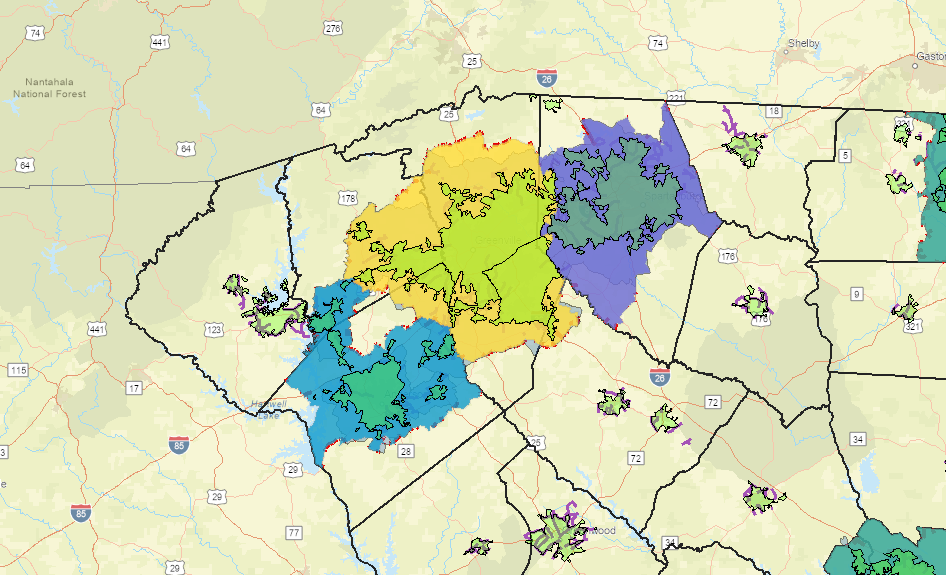Census Forces New MPO Lines
Source: SC DOTWe all know that the Census is used to draw “lines” across our country. Most notably, Census data is used to redraw district lines from Congress down to City Council - redistricting. Those lines get a lot of headlines. But the Census is responsible for a lot of other “lines”.
Today, we’ll talk about Metropolitan Planning Organization (MPO) lines. We’ll try to be as clear and concise as we can. This is a pretty dry subject, BUT it could mean millions in transportation funding for some areas of the region.
Urbanized Areas
The Census, last conducted in 2020, is central to nearly every type of federal program out there, including transportation.
In particular for this topic, the Census Bureau uses their data to define “Urbanized Areas” (UAs), better thought of as general areas of population concentration - where a fair number, to a lot, of people live.
Here’s a breakdown of what a UA is and what parameters are used in defining them throughout the country. Note that not everyone lives in an UA, you need a certain level of population to be considered an “Urbanized Area”.
After the Census data was studied, the Census Bureau released new UA boundaries. Some critical changes happened in our Upstate region of South Carolina. Namely, Clemson and Pendleton areas moved to be part of the new Anderson-Clemson UA; the Mauldin-Simpsonville-Five Forks-Fountain Inn areas solidified as a new Mauldin-Simpsonville UA; and the Williamston-Pelzer-West Pelzer areas moved out of the Greenville UA into their own small UA.
After the UAs are released, a ton of federal programs are impacted - and a lot more “lines” are drawn.
One important “line” - Metropolitan Planning Organization (MPO) boundaries.
MPOs
MPOs, in short, have jurisdiction over how a number of transportation-related funding is prioritized at the local level. MPOs take their lines of jurisdiction first from the various UAs in their area, plus areas surrounding the UAs. Think of it as a region, centered around urbanized areas of a certain size (minimum 50,000 people, and then another level at 200,000).
MPOs are governed by committees who approve that MPO’s Transportation Improvement Program (TIP) and Long Range Transportation Plans (LRTP). These two documents govern how millions of dollars are spent on road improvements, trails, public transit systems, and more.
In our region, we have three (3) MPOs:
Spartanburg Area Transportation Study (SPATS)
*Name change noted in next section
Most of the region’s population lives within the boundary of one of those MPOs, but not everyone. For those outside the MPO lines, the funding decisions made usually by an MPO are then made by the regional Council of Governments (COG) — that topic is for another day.
Here is a great breakdown from the state of Florida on the difference between UAs and MPOs, and the criteria for each (based on 2010 Census).
MPO Boundary Changes
As part of the changes to the UAs, the MPOs all now have to adjust their boundaries - where they have jurisdiction - where they can fund transportation improvement projects.
Here is a draft of the new MPO lines statewide. Light colors are MPO lines, dark colors are UA lines.
Here are some key changes coming out of the revamped MPO lines in our region:
Clemson Moves to Renamed ACATS (formerly ANATS)
Notable Impact: CATbus, Clemson’s bus system, now joins the same MPO as Anderson’s Electric City Transit. CATbus will now also be classified as a more rural bus system, meaning they will go through SCDOT more for their reporting instead of the Federal Transit Authority (FTA).Williamston + Pelzer + West Pelzer Move to ACATS
Notable Impact: Even though ACATS receives less overall funding than GPATS, these smaller cities, plus Clemson (above), will no longer compete with larger urban areas like Greenville for funding of some projects.SPATS Grows West, GPATS Shrinks
Notable Impact: The GPATS border used to go well into Spartanburg County. With Spartanburg’s growth, those lines moved, allowing SPATS to grow, and GPATS to move slightly closer to the county line. Places like Greer, which straddles the county line, will still have to work with two MPOs potentially.GPATS Grows North
Notable Impact: GPATS’s boundary will move further north, well above Travelers Rest and Marietta.
What’s Next
Each MPO has to approve their draft boundary lines - many are just starting that process now as DOT released the draft maps only late this Summer. Then, the state will formally submit those changes to the federal government.
Changes take place immediately, but for projects in the pipeline that may be located in an area changing MPOs - if there’s money committed, the project will stay in the current MPO through completion, and if no money has been committed, the project will move to the new MPO.
Bottom Line
The numbers are not yet in on what the fiscal impact of these changes will be. Funding will most likely go up for all of our local MPOs as population numbers overall increased (even if them map area decreased), and due to the state committing more money to MPOs this year.
Note
MPOs do not govern all transportation funding locally - and that’s important to keep in mind. There are still City Councils, County Councils, SC-DOT, County Transportation Committees (CTCs), and then of course the US DOT itself. But MPOs are important for transportation advocates to be aware of and monitor - because these “lines” can matter more than money.


